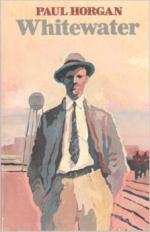|
This section contains 221 words (approx. 1 page at 300 words per page) |

|
Whitewater probably owes some of its popularity to the examples set by Henry Bellaman's King's Row (1943), Grace Metalious's Peyton Place (1956) and Larry McMurtry's The Last Picture Show (1966), which also chronicle the private lives and secret transgressions of entire communities. McMurtry's novel even shares the same West Texas setting, as does his earlier novel Leaving Cheyenne (1963), also about two friends who love the same woman.
Perhaps a more flattering precedent than Peyton Place for the texture of gossipy details found in Whitewater is Sherwood Anderson's Winesburg, Ohio (1919). Horgan's knack for conjuring feelings that strike a chord of universal nostalgia inevitably leads to comparisons with Thomas Wolfe; and as a story of youth, Whitewater belongs to the tradition of Mark Twain's Huckle berry Finn (1884).
There seems also to be a certain influence of Thomas Mann's short story classic "Tonio Kroger" (1903). Like Phil, Tonio envies his friend Hans for...
|
This section contains 221 words (approx. 1 page at 300 words per page) |

|




